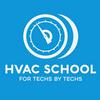870 episodes

Sizing Breakers and Conductors (for HVAC) – Have Things Changed?
01/1/2026 | 35 mins.
In this essential episode, Bryan Orr sits down with Elliot, the residential install supervisor at Kalos Services, to unpack a critical issue that's causing confusion among HVAC technicians, electricians, and inspectors alike: the new standards for breaker and conductor sizing on inverter-driven equipment. The conversation was sparked by Elliot's frustrating experience of having two inspectors in the same county fail the same installation for opposite reasons—one for an oversized breaker and another for an undersized breaker. This contradiction led to a deep dive into recent changes in UL standards and how they affect everyday HVAC installations. The heart of the issue stems from the transition to low-GWP refrigerants and the updated UL 60335-2-40 Edition 3 standard, which replaced the 1995 certification approach. This new standard introduced more conservative calculations for electrical characteristics, particularly affecting equipment using A2L refrigerants. The result? Data tags now show higher Minimum Circuit Ampacity (MCA) ratings than before, even though the equipment itself hasn't changed—only the math used to calculate these values has shifted. This has created a puzzling situation where the MCA can be higher than the recommended breaker size, which seems counterintuitive to anyone familiar with traditional electrical principles. Bryan and Elliot clarify the fundamental rule that still applies: size your wire to the MCA and your breaker to the MOCP (Maximum Overcurrent Protector). The confusion arises because manufacturers like Mitsubishi are now including "recommended breaker" sizes on data tags that are lower than the MCA—a courtesy to contractors, not a code requirement. The higher MCA reflects conservative safety margins that account for extreme operating conditions, but in practice, inverter-driven systems have multiple built-in protections that prevent them from ever actually reaching these calculated amperage levels. The key takeaway is that contractors can safely install breakers at the recommended size without safety concerns, as long as the breaker's lugs are rated to accept the wire size required by the MCA. The episode also explores how inverter-driven equipment fundamentally differs from traditional PSC motors, particularly regarding locked rotor amps (now more accurately termed "inverter input") and voltage drop considerations. Unlike conventional motors that simply run slower with reduced voltage, inverter-driven compressors and ECM motors compensate by drawing more current to maintain performance, creating a potential compounding effect with voltage drop that installers need to understand—even though voltage drop itself isn't an enforceable NEC code requirement. Topics Covered: New UL 60335-2-40 Edition 3 standards and their impact on electrical calculations for HVAC equipment The relationship between MCA (Minimum Circuit Ampacity) and MOCP (Maximum Overcurrent Protector) and why they can now seem contradictory Recommended breaker sizes on modern data tags and why they may be lower than the MCA Handling inspector conflicts and failed inspections related to breaker sizing Differences between inverter-driven equipment and traditional PSC motors in electrical behavior The transition from "locked rotor amps" to "inverter input" terminology for modern equipment Voltage drop considerations with inverter-driven systems (NEC 210.19A and 215.2A) Why inverter-driven equipment draws more current at lower voltages compared to traditional motors Proper wire and breaker sizing for A2L refrigerant equipment (454B systems) NEC Section 440 requirements specific to air conditioning and refrigeration equipment Breaker lug ratings and ensuring they can accept the required wire size Practical advice for communicating with inspectors and resolving code disputes Read the tech tip on this topic HERE. Have a question that you want us to answer on the podcast? Submit your questions at https://www.speakpipe.com/hvacschool. Purchase your tickets or learn more about the 7th Annual HVACR Training Symposium at https://hvacrschool.com/symposium. Subscribe to our podcast on your iPhone or Android. Subscribe to our YouTube channel. Check out our handy calculators here or on the HVAC School Mobile App for Apple and Android.

Absorption Cooling - The Rise and Fall and Rise - Short #272
30/12/2025 | 12 mins.
In this short podcast episode, Bryan goes on another history journey, retelling the story of the rise and fall and rise of absorption cooling. Some of the first HVAC/R engineers cooled buildings with fire; they used absorption refrigeration, which ran on heat instead of electricity. In the early 1800s, French scientist Michael Faraday showed that gases like ammonia could absorb heat as they evaporated. Instead of compressing the vapor, engineers looked for a way to absorb the heat from the vapor and drive it back out. In 1859, Ferdinand Carré invented a machine that boiled ammonia, absorbed the vapor into water, and reheated the mixture to desorb the ammonia, creating a self-contained refrigeration machine powered by heat alone (including waste steam from boilers). This ammonia-water absorption machine could freeze water and chill brine, and it became popular in the 1880s. An absorption system has an evaporator that boils refrigerant, which is then absorbed into another liquid and creates a strong solution. Heat drives refrigerant back out of the solution as a vapor, where it is then condensed back to a liquid and metered. However, while they were reliable, they were heavy, expensive, and slow to respond. In the 1920s and 1930s, the rise of practical sealed electric compression systems began replacing absorption refrigeration infrastructure. By the mid-1900s, absorption chillers were replaced in all but a few applications. Absorption didn't completely vanish, in part thanks to Servel, which continued manufacturing absorption refrigeration systems for industrial applications and rural areas with unreliable electricity. By the 1960s, Japan and Europe refined the design with lithium bromide instead of ammonia. Absorption chillers are still present, but their complexity, maintenance demands, and poor efficiency still make them impractical for most refrigeration purposes. However, with concerns about the electrical grid and decarbonization initiatives on the rise, absorption refrigeration in hybrid systems with improved efficiency and a heat source obtained from gas turbines and biomass boilers looks promising. Have a question that you want us to answer on the podcast? Submit your questions at https://www.speakpipe.com/hvacschool. Purchase your tickets or learn more about the 7th Annual HVACR Training Symposium at https://hvacrschool.com/symposium. Subscribe to our podcast on your iPhone or Android. Subscribe to our YouTube channel. Check out our handy calculators here or on the HVAC School Mobile App for Apple and Android.

Combustion Analysis w/ Tony G.
25/12/2025 | 50 mins.
In this comprehensive training session from the symposium, Tony Gonzalez, Training Director at Fieldpiece, delivers an engaging and practical guide to combustion analysis for HVAC technicians. With 25 years of experience at Fieldpiece—from warehouse worker to training director—Tony brings both technical expertise and real-world application to this 50-minute interactive session focused on the company's CAT 85 combustion analyzer. Tony emphasizes that combustion analysis serves four critical purposes: safety, efficiency, equipment specification verification, and liability protection. He makes a compelling business case for investing in combustion analyzers, noting that preventing just two callbacks or one liability lawsuit can pay for the equipment ten times over. The training walks attendees through the complete process, from properly warming up the analyzer in fresh air (allowing sensors to calibrate to ambient oxygen and zero carbon monoxide) to generating professional PDF reports that can be shared with customers or integrated into work order management systems like ServiceTitan. The session provides detailed guidance on interpreting key measurements, including stack temperature, oxygen percentage, carbon monoxide levels, and draft pressure. Using design parameters from the National Comfort Institute, Tony demonstrates how to diagnose issues by comparing actual readings against acceptable ranges for different furnace types (atmospheric, 80% induced fan, and 90+ percent condensing). He walks through practical troubleshooting scenarios, showing how measurements like high oxygen combined with low stack temperature can point to specific problems like low gas pressure that technicians can then verify and correct. Throughout the presentation, Tony emphasizes proper technique and best practices, from creating test ports at least 12 inches above the inducer fan to the importance of plugging test ports after completion. He also highlights innovative features of Fieldpiece's analyzers, including the hydro cycle pump that eliminates traditional water traps, sensor vault technology that extends sensor life to four years, and built-in wireless connectivity allowing technicians to view measurements on their mobile devices through the Job Link app. Topics Covered: Why perform combustion analysis: Safety verification, efficiency optimization, OEM specification compliance, and liability protection Business benefits: Reducing callbacks, improving OEM relationships, enhancing professional image, and protecting against lawsuits Proper startup procedure: Warming up analyzers in fresh air for accurate oxygen and CO sensor calibration Ambient CO testing: Using combustion analyzers vs. dedicated walk-around detectors for carbon monoxide detection in living spaces Test port installation: Proper placement at least 12 inches above inducer fans and away from 90-degree elbows Key measurements explained: Stack temperature, oxygen percentage, CO PPM, CO air-free, draft pressure, and efficiency calculations Equipment type selection: Choosing correct settings for atmospheric, 80% induced fan, or 90+ percent condensing furnaces Diagnostic interpretation: Using National Comfort Institute parameters to identify issues like excess combustion air or low gas pressure Advanced features: Built-in dual port manometer for gas and static pressure, wireless Job Link app connectivity, and hydro cycle pump technology Report generation: Creating professional PDF reports with company branding for customer documentation and CYA protection Maintenance tips: Checking particle filters, understanding sensor vault technology, and the importance of annual calibration Sensor longevity: Four-year sensor life warranty and field-replaceable sensors without sending equipment for service Have a question that you want us to answer on the podcast? Submit your questions at https://www.speakpipe.com/hvacschool. Purchase your tickets or learn more about the 7th Annual HVACR Training Symposium at https://hvacrschool.com/symposium. Subscribe to our podcast on your iPhone or Android. Subscribe to our YouTube channel. Check out our handy calculators here or on the HVAC School Mobile App for Apple and Android.

Give Until it Hertz - The Battle Over Frequency - Short #271
23/12/2025 | 13 mins.
In this short podcast episode, we go back into the history of the trades, namely the battle over frequency (and how each side had to give until it hertz). The low hum of motors is alternating current: electricity moving back and forth through copper 60x per second (in the USA and Canada, at least). In another version of history, that pulse could be 50x per second instead (as in much of the remainder of the world). The forgotten frequency war is the lesser-known sequel to the war of the currents. Tesla's AC power prevailed over Edison's DC, but different motor and generator companies chose different alternating current frequencies. Westinghouse chose 60 cycles per second, whereas General Electric experimented with 25-40 cycles per second, and Europe-based Siemens and AEG standardized around 50 hertz. These different frequencies set the rhythm for everything that turns or glows, and electric parts that didn't match often failed. Nevertheless, the engineers of the companies defended their own frequencies. In the 1910s, the US began merging electrical grids to set a single standard. Westinghouse had the most dominant technology at the time, and 60 hertz became the norm in the USA. However, across the pond, 50 hertz made more sense for the European infrastructure that was in place and being rebuilt after WWI, and it was solidified by the rebuilding efforts of WWII. As a result, roughly 2/3 of the planet uses a 50-hertz frequency. The two frequencies are incompatible because motors will travel at a different speed than their design while drawing the same current, leading to reduced capacity or overheating. In the 1960s, international companies produced dual-rated compressors and motors, but global trade is still complicated by different frequencies, and moving entirely to a single frequency is impractical due to the infrastructure disruption required. However, modern VFDs and inverter technology can change frequencies as they enter the motor, thus solving the battle over frequency and reminding us that flexibility is the real future. Have a question that you want us to answer on the podcast? Submit your questions at https://www.speakpipe.com/hvacschool. Purchase your tickets or learn more about the 7th Annual HVACR Training Symposium at https://hvacrschool.com/symposium. Subscribe to our podcast on your iPhone or Android. Subscribe to our YouTube channel. Check out our handy calculators here or on the HVAC School Mobile App for Apple and Android.

Residential vs. Commercial HVAC Sales
18/12/2025 | 50 mins.
In this candid conversation, Nathan and Bryan dive deep into the often-misunderstood world of sales in the construction and HVAC trades. Nathan, who has transitioned from fieldwork to spending roughly 60% of his time in sales, offers a unique perspective on why sales professionals are necessary despite the skepticism they face from tradespeople. The discussion tackles head-on the negative perceptions surrounding salespeople while making a compelling case for their essential role in growing and sustaining a trades business. The conversation explores the fundamental differences between residential and commercial sales, revealing insights that anyone in the industry will find valuable. Nathan explains that residential sales requires quick relationship-building, subject matter expertise, and the ability to emotionally connect and disconnect rapidly from customers you may only see every few years. It's essentially retail sales with a technical component. Commercial B2B sales, on the other hand, is far less transactional and much more relational—it's about building confidence, managing accounts effectively, and ensuring clients can focus on their core business while you handle their facility problems seamlessly. One of the most refreshing aspects of this discussion is Nathan's honesty about the unglamorous side of sales. He emphasizes that the job isn't about fancy lunches or golf outings—it's about being the person who answers their phone, follows through on commitments, and doesn't shy away from uncomfortable conversations. The guys share frustrating examples of poor salesmanship, from ghosting potential clients to making promises that can't be kept, illustrating how these failures give the entire profession a bad reputation. Nathan stresses that good sales is fundamentally about managing expectations, delivering on promises, and serving as the crucial liaison between customer needs and production capabilities. The conversation concludes with practical advice for tradespeople considering a move into sales: if you're motivated by the chase, enjoy solving people's problems, and find satisfaction in knowing your work directly impacts the bottom line, sales might be for you. But if you're just looking for an easier path with less physical labor, think again—great salesmanship is mentally demanding work that requires constant follow-through and resilience. Topics Covered: Why tradespeople are often critical of sales and the misconceptions about the profession The difference between "good" and "bad" salespeople and the moral use of sales skills Essential traits for successful residential HVAC salespeople, including product knowledge and emotional agility How commercial B2B sales differs from residential—less transactional, more relational The critical importance of follow-through, responsiveness, and keeping promises in account management Why sales serves as the essential "oil in the machine" that prevents business breakdowns The role of salespeople in managing customer expectations and protecting production teams The unsexy reality of sales work: constant uncomfortable conversations and problem-chasing When entertaining clients (golf, lunches) is appropriate versus when it becomes buying work Advice for tradespeople considering transitioning into sales roles Have a question that you want us to answer on the podcast? Submit your questions at https://www.speakpipe.com/hvacschool. Purchase your tickets or learn more about the 7th Annual HVACR Training Symposium at https://hvacrschool.com/symposium. Subscribe to our podcast on your iPhone or Android. Subscribe to our YouTube channel. Check out our handy calculators here or on the HVAC School Mobile App for Apple and Android.
More Business podcasts
Trending Business podcasts
About HVAC School - For Techs, By Techs
Listen to HVAC School - For Techs, By Techs, Money Made Simple and many other podcasts from around the world with the radio.net app

Get the free radio.net app
- Stations and podcasts to bookmark
- Stream via Wi-Fi or Bluetooth
- Supports Carplay & Android Auto
- Many other app features
Get the free radio.net app
- Stations and podcasts to bookmark
- Stream via Wi-Fi or Bluetooth
- Supports Carplay & Android Auto
- Many other app features


HVAC School - For Techs, By Techs
download the app,
start listening.






































